The aseptic conditions ensured by of laminar flow hood

Agarwal Packers and Movers
March 15, 2019
Know How to Migrate Exchange Mailbox to Office 365
March 15, 2019It is important to understand the concept of laminar flow. It can be defined as the flow of air within an enclosure or specific space where the velocity as well as the direction of air flow remains uniform within that particular space. This is particularly applicable for laboratory containers or cabinets that require this kind of airflow.
Understanding the structural construct of a laminar flow hood
The hood that ensures laminar flow is so constructed that the air which is HEPA filtered can flow in a particular velocity within the safety limits of the cabinet. The presence of these hoods ensures that the specimens or items present on the work surface are actively protected from contamination. Hoods are also made to ensure the safety of the experimenter from the toxins present in a particular area.
The working principle and primary functions of a laminar hood
The principle on which the airflow is dependent in case of laminar hoods and Laboratory Fume Hoods was developed to guarantee the safe movement of air within the enclosures present in laboratories. The application of modern technology has evolved the construction of laminar hoods depending upon the type of laboratory for which it is installed. However the chief functions of this hood remains unaltered and includes the following:
- Maintaining a sterile atmosphere.
- Averting any form of cross-contamination.
- Checking the turbulence.
Hence how laminar flow hood works can be delineated as the constant maintenance of unidirectional flow of the air.
The way in which laminar air flow is utilized for different types of laboratory equipment
Laminar flow hoods are also known as Class II Bio-safety Cabinets. These cabinets actively maintain the protection of products by ensuring the downward laminar flow of HEPA-filtered air over the work arena. These cabinets having circulating air also include an internal airflow which is present at the front in order to protect the laboratory operators. The different kinds of equipments fitted with laminar flow for ensuring that specific kind of air flow are discussed below:
- Laminar flow that is vertical is suitable for PCR workstations, and also for enclosures which are particularly designed for conducting experiments on polymerase that involves chain reactions. The air flow through HEPA filtration will ensure that there is no suspended particulate matter in the work area. A UV light is also present for additional decontamination of genetic material.
- Clean benches are often used for culturing tissues and needs to be kept sterile and pollutant free. The top of a clean bench is fitted with a pre-filter so that the air is drawn in. the HEPA filter is present for pulling out the air from the clean bench.
- In both vertical and horizontal clean bench the laminar air is projected appropriately. In the vertical bench the projection is over the work station whereas in case of the horizontal bench the projection is pointed at the operator.
Hence it can be said that in all instances, a particulate-free zone is ensured by laminar flow.


